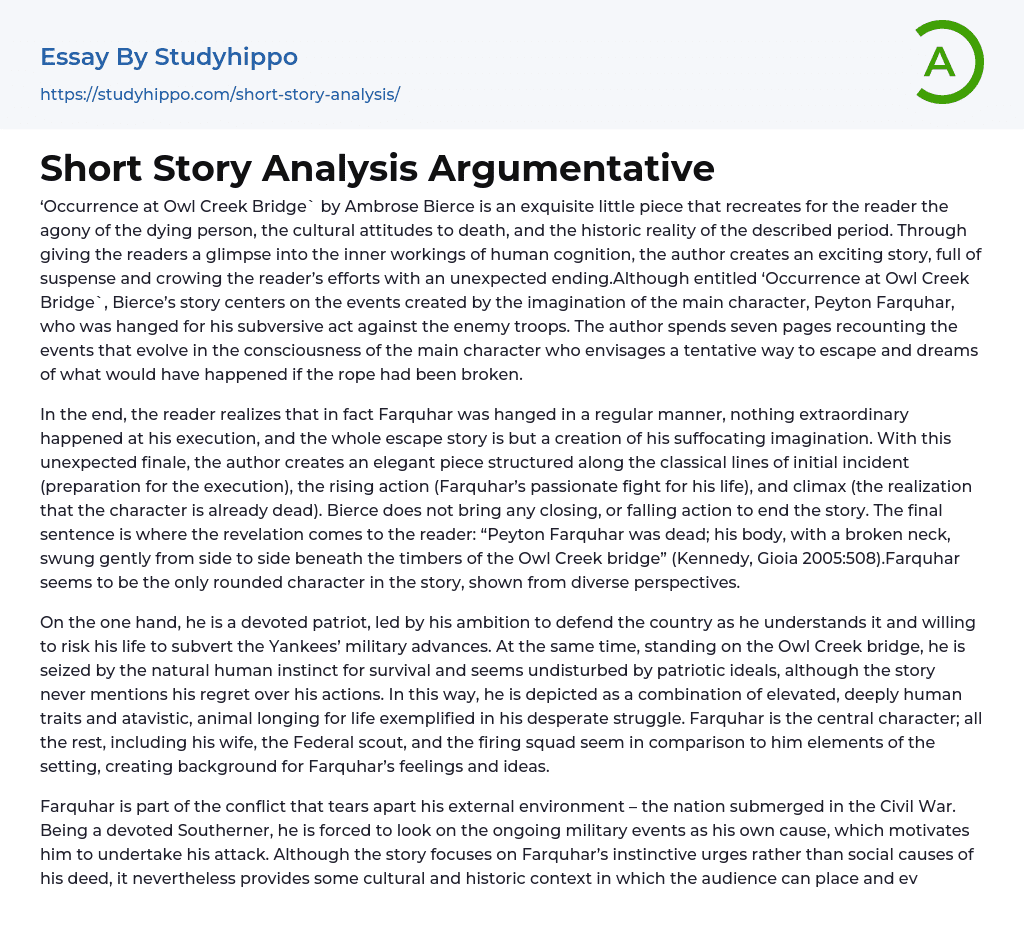‘Occurrence at Owl Creek Bridge` by Ambrose Bierce is an exquisite little piece that recreates for the reader the agony of the dying person, the cultural attitudes to death, and the historic reality of the described period. Through giving the readers a glimpse into the inner workings of human cognition, the author creates an exciting story, full of suspense and crowing the reader’s efforts with an unexpected ending.Although entitled ‘Occurrence at Owl Creek Bridge`, Bierce’s story centers on the events created by the imagination of the main character, Peyton Farquhar, who was hanged for his subversive act against the enemy troops. The author spends seven pages recounting the events that evolve in the consciousness of the main character who envisages a tentative way to escape and dreams of what would have happened if the rope had been broken.
...In the end, the reader realizes that in fact Farquhar was hanged in a regular manner, nothing extraordinary happened at his execution, and the whole escape story is but a creation of his suffocating imagination. With this unexpected finale, the author creates an elegant piece structured along the classical lines of initial incident (preparation for the execution), the rising action (Farquhar’s passionate fight for his life), and climax (the realization that the character is already dead). Bierce does not bring any closing, or falling action to end the story. The final sentence is where the revelation comes to the reader: “Peyton Farquhar was dead; his body, with a broken neck, swung gently from side to side beneath the timbers of the Owl Creek bridge” (Kennedy, Gioia 2005:508).Farquhar seems to be the only rounded character in the story, shown
from diverse perspectives.
On the one hand, he is a devoted patriot, led by his ambition to defend the country as he understands it and willing to risk his life to subvert the Yankees’ military advances. At the same time, standing on the Owl Creek bridge, he is seized by the natural human instinct for survival and seems undisturbed by patriotic ideals, although the story never mentions his regret over his actions. In this way, he is depicted as a combination of elevated, deeply human traits and atavistic, animal longing for life exemplified in his desperate struggle. Farquhar is the central character; all the rest, including his wife, the Federal scout, and the firing squad seem in comparison to him elements of the setting, creating background for Farquhar’s feelings and ideas.
Farquhar is part of the conflict that tears apart his external environment – the nation submerged in the Civil War. Being a devoted Southerner, he is forced to look on the ongoing military events as his own cause, which motivates him to undertake his attack. Although the story focuses on Farquhar’s instinctive urges rather than social causes of his deed, it nevertheless provides some cultural and historic context in which the audience can place and evaluate Farquhar’s actions. Thus, he is viewed with deference by soldiers to whom “death is a dignitary who when he comes announced is to be received with formal manifestations of respect, even by those most familiar with him” (Kennedy, Gioia 2005:503). The cultural concepts and understanding emerge in the interpretation of Farquhar’s appearance that, given his habit “of a planter” he was “no vulgar assassin” (Kennedy, Gioia 2005:503).
The most interesting feature
of the story is perhaps its treatment of time. Although in fact the events evolve in a very short time span, except for the flashback to the time when Farquhar makes his fatal decision to disrupt the movement of the Union Army, the actions that flash in the character’s mind would in reality occupy at least a day. Farquhar’s fall into the river, his swimming along in order to escape the fire of the soldiers, landing on the shore of the creek, the night in the forest, meeting his wife and children at sunlight – all this is suppressed into few brief seconds in which the character struggles for his life on the rope. The conflict between the long story and the short time, abundance of detail for the imaginary action, the interesting exploration of the relationship between the conscious and the subconscious makes Bierce’s narrative a thought-provoking and impressive work of short fiction.
- Age Of Enlightenment essays
- Ethos essays
- Time essays
- Acceptance essays
- Meaning Of Life essays
- Reality essays
- Natural Law essays
- Political Philosophy essays
- Utilitarianism essays
- Existence essays
- Free Will essays
- Good And Evil essays
- Confucianism essays
- Relativism essays
- Conscience essays
- Environmentalism essays
- Empiricism essays
- Epistemology essays
- Ethics essays
- Existentialism essays
- Human Nature essays
- Individualism essays
- Metaphysics essays
- Philosophy Of Life essays
- Transcendentalism essays
- Truth essays
- Destiny essays
- Determinism essays
- Fate essays
- Functionalism essays
- Philosophers essays
- Pragmatism essays
- Future essays
- Child Observation essays
- Critical Reflection essays
- Teaching Philosophy essays
- Personal Philosophy essays
- Action Speak Louder Than Words essays
- Can Money Buy Happiness essays
- Values of Life essays
- Ethical dilemma essays
- Normative Ethics essays
- Virtue Ethics essays
- Belief essays
- Deontology essays
- Moral essays
- Virtue essays
- Work Ethic essays
- Henry David Thoreau essays
- Carl Jung essays




